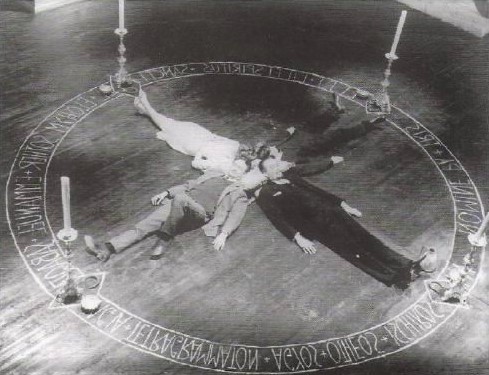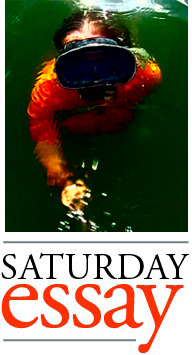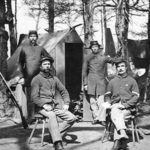Glensheen Denies Occult Rituals of Disgraced Congdon Nephew
Last year the Minnesota historian Peter S. Svenson wrote an unpublished monograph, “The Forgotten Duluth Painter, Edward Alexander Congdon.” Svenson gave me the following information in an interview conducted on Halloween as luck would have it.
Edward Alexander (a nephew of Chester Congdon) lived at Glensheen, the historic Congdon estate. He hid slightly pointy ears with clever hair styling. But, enlisting in the armed forces to fight World War I, he suffered a military haircut. At Belleau Wood a German flame-thrower splashed liquid fire into his trench, and he escaped with his life unlike some of his fellows. But much of the skin had been burned off the top of his head, including his right ear and his eyebrows. Once healed, hair grew toward the back of his head, and the scar tissue of the high forehead became less noticeable with time. However, his eyebrows remained white scars, and the right ear had burned off down to the hole. Aleister Crowley said, “The effect of that, with his one remaining devil’s-ear, was striking.”
Edward Alexander remained overseas for a time after the war. He wandered the world using his unsettling appearance as currency in mediumistic parlors and spiritualist circles. He joined the Ordo Templi Orientis in England, and enjoyed esotericists he met in France. Then he joined the Hermetic Order of the Golden Dawn, mingling with Sir Arthur Conan Doyle and W.B. Yeats. He painted, climbed the Eiger, and had lucid dreams of the dead. Returning stateside in 1923, he lived in the Glensheen attic, “like a bat,” Mrs. Congdon used to say.
Back in Black
Edward Alexander brought Phoenecian urns home that he had either excavated himself or purchased in back-alley antiquities markets. He believed them to contain ancient remains of child sacrifices to blasphemous elder gods. Many of these urns remain in the Glensheen collection and are sometimes accidentally rotated into the public displays by neophyte staff members unaware of the tiny bones and teeth therein. Edward Alexander wrote that “the contents of the urns had been scraped from the pyres of humanity’s cradle; the macabre residue of rituals so terrible, even cruel Rome sent armies to burn the civilization to the ground and erase it from the earth.”
Besides collecting and painting, Edward Alexander spent time translating occult texts and consecrating talismans. And smoking hashish, another European habit he brought home from the war. Mrs. Congdon would call upstairs, “Edward Alexander, what is that smell?” The sound of flutes and drums emanated from the attic, leading some to wonder if he had snuck visitors upstairs through the mansion’s secret passageways. The maids whispered among themselves that the unseen guests had gained access via the arcane realms. Edward Alexander claimed he had discovered the attic was larger on the inside than the outside, a claim defying the dreams of Euclid and Descartes, but the maids took it as confirmation that he was in contact with the netherworld.
He held Duluth painting exhibitions to critical acclaim, but his entire body of work appeared to have been destroyed by fire in 1927, at a controversial exhibit in the mezzanine of the Orpheum Theater. Local pastors blamed the fire on the “Satanic influences” of the work, implying the Devil himself dwelled in the paintings which leaked the fires of Hell through the canvasses. Edward Alexander shot back in the pages of the Duluth News-Tribune: “I have been victimized by holy arsonists.” The case descended into his lawsuits and countersuits with the Orpheum, settled out of court. The origin of the mystery fire was never solved.
Glensheen spokespersons deny occult rituals have ever taken place at the manor. However, records from the 1920s describe “Eyes Wide Shut” sex parties whenever the rest of the Congdon family was out of town — Edward Alexander emerged from the attic and profaned the house with members of local secret societies. One of these societies was the Duluth branch of the Ordo Templi Orientis with its sex magic emphasis. Edward Alexander seized control of the Duluth branch, brandishing his OTO bona fides from Europe where he had achieved the rank of Prince of the Royal Secret.
He believed in the existence of a lake beneath Lake Superior, the near-mythical Lake Inferior that swallowed a diver in 1870 only to be sealed over by the city and forgotten. Edward Alexander used ritual in attempts to access the hidden lake and raise its monsters by controlling their wills. This was dismissed by scholars until the 2019 discovery of the Glensheen diving bell. The detail omitted from news reports was that the diving bell contained consecrated amulets of protection from the supernatural. To date, no entrance to Lake Inferior has been found in or around the waters of the estate, but Svenson speculates it was just off the dock, and that the Congdons had it sealed over after Edward Alexander disappeared in 1930.

This photo is believed by some to be from Glensheen circa 1925.
The Attic
The attic was sealed and no one was admitted until exorcists could perform rituals that, three maids insisted, drove these men of the cloth insane. According to Svenson, asylum interviews with surviving exorcists were suppressed by the estate, the university, and the church. Rumors that a self-portrait still hangs in a corner of the attic, the eyes of which follow you around the room and appear to blink at dawn, are unfounded — so it is said. Claims of hidden chambers and passageways are likewise denied, but covertly encouraged to goose ticket sales. An additional portrait was discovered in the cellar in 1931 which so shocked the maid who found it, she was taken to a local asylum with a nervous disorder. She committed suicide in 1933.
In 1948 a series of shocking nudes was discovered in the attic revealing a whole other life, a lost chapter of his oeuvre. That work is not on public view and no prints have been made. The conservators hint that the pictures have developed demonic airs over the years, suggesting actual infernal contact, or more likely (according to Svenson) retouches added over time by a cult of adepts still employed at the mansion. Artifacts discovered in the attic included a salt and gunpowder pentagram on the floor which stained the wood with corrosion and scorches. Tour guides can point to faint traces beneath the varnish.
Books on Edward Alexander’s shelf included À rebours (“Against Nature”), The Picture of Dorian Gray, a Coleridge translation of Faust, and a 1927 issue of Weird Tales dog-eared at the Lovecraft story “Pickman’s Model.” He kept a copy of the Bible, but the pages appear virginal except for the Book of Revelation, which shows evidence of study. Handwritten notes are scrawled in the margins, including physics equations, glyphs, and symbols. It is difficult to distinguish where physics equations end and sorcerous esoterica begin. The Greek letters of complex mathematics mix inextricably with the arcane formulae of demonology. A quote by the mystic, Eliphas Levi, is likewise found in the margins: “It is magic alone which imparts true science.” Svenson reminds us that Levi once described magic as “the fatal science of good and evil.”
It remains a possibility that Edward Alexander died inside one of the home’s obscure secret passageways, and that his body lies behind one of the many walls, or perhaps beneath the floorboards in a forgotten abattoir, inches from the soles of the tourists.
UPDATE: Occultists Deny “Glensheen Denies Occult Rituals” Story
An index of Jim Richardson’s essays can be found here.
Recommended Links:
Leave a Comment
Only registered members can post a comment , Login / Register Here















No Comments